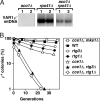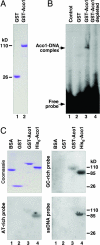Yeast aconitase binds and provides metabolically coupled protection to mitochondrial DNA
- PMID: 17698960
- PMCID: PMC1959452
- DOI: 10.1073/pnas.0703078104
Yeast aconitase binds and provides metabolically coupled protection to mitochondrial DNA
Abstract
Aconitase (Aco1p) is a multifunctional protein: It is an enzyme of the tricarboxylic acid cycle. In animal cells, Aco1p also is a cytosolic protein binding to mRNAs to regulate iron metabolism. In yeast, Aco1p was identified as a component of mtDNA nucleoids. Here we show that yeast Aco1p protects mtDNA from excessive accumulation of point mutations and ssDNA breaks and suppresses reductive recombination of mtDNA. Aconitase binds to both ds- and ssDNA, with a preference for GC-containing sequences. Therefore, mitochondria are opportunistic organelles that seize proteins, such as metabolic enzymes, for construction of the nucleoid, an mtDNA maintenance/segregation apparatus.
Conflict of interest statement
The authors declare no conflict of interest.
Figures






Similar articles
-
Aconitase couples metabolic regulation to mitochondrial DNA maintenance.Science. 2005 Feb 4;307(5710):714-7. doi: 10.1126/science.1106391. Science. 2005. PMID: 15692048
-
Mitochondrial DNA, aconitase 'wraps' it up.Trends Biochem Sci. 2005 Jun;30(6):294-6. doi: 10.1016/j.tibs.2005.04.007. Trends Biochem Sci. 2005. PMID: 15950872 Review.
-
Irc3 is a mitochondrial DNA branch migration enzyme.Sci Rep. 2016 May 19;6:26414. doi: 10.1038/srep26414. Sci Rep. 2016. PMID: 27194389 Free PMC article.
-
Mitochondrial DNA instability in cells lacking aconitase correlates with iron citrate toxicity.Oxid Med Cell Longev. 2013;2013:493536. doi: 10.1155/2013/493536. Epub 2013 Aug 26. Oxid Med Cell Longev. 2013. PMID: 24066190 Free PMC article.
-
Yeast and human mitochondrial helicases.Biochim Biophys Acta. 2013 Aug;1829(8):842-53. doi: 10.1016/j.bbagrm.2013.02.009. Epub 2013 Feb 27. Biochim Biophys Acta. 2013. PMID: 23454114 Review.
Cited by
-
Kinetic and Regulatory Properties of Yarrowia lipolytica Aconitate Hydratase as a Model-Indicator of Cell Redox State under pH Stress.Int J Mol Sci. 2023 Apr 21;24(8):7670. doi: 10.3390/ijms24087670. Int J Mol Sci. 2023. PMID: 37108831 Free PMC article.
-
Nitric Oxide Improves the Tolerance of Pleurotus ostreatus to Heat Stress by Inhibiting Mitochondrial Aconitase.Appl Environ Microbiol. 2020 Feb 18;86(5):e02303-19. doi: 10.1128/AEM.02303-19. Print 2020 Feb 18. Appl Environ Microbiol. 2020. PMID: 31862720 Free PMC article.
-
Aconitase regulation of erythropoiesis correlates with a novel licensing function in erythropoietin-induced ERK signaling.PLoS One. 2011;6(8):e23850. doi: 10.1371/journal.pone.0023850. Epub 2011 Aug 22. PLoS One. 2011. PMID: 21887333 Free PMC article.
-
Mutations in the dimer interface of dihydrolipoamide dehydrogenase promote site-specific oxidative damages in yeast and human cells.J Biol Chem. 2011 Nov 18;286(46):40232-45. doi: 10.1074/jbc.M111.274415. Epub 2011 Sep 19. J Biol Chem. 2011. PMID: 21930696 Free PMC article.
-
A quantitative screen for metabolic enzyme structures reveals patterns of assembly across the yeast metabolic network.Mol Biol Cell. 2019 Oct 1;30(21):2721-2736. doi: 10.1091/mbc.E19-04-0224. Epub 2019 Sep 4. Mol Biol Cell. 2019. PMID: 31483745 Free PMC article.
References
-
- Rouault TA. Nat Chem Biol. 2006;2:406–414. - PubMed
-
- Dupuy J, Volbeda A, Carpentier P, Darnault C, Moulis JM, Fontecilla-Camps JC. Structure (London) 2006;14:129–139. - PubMed
-
- Walden WE, Selezneva AI, Dupuy J, Volbeda A, Fontecilla-Camps JC, Theil EC, Volz K. Science. 2006;314:1903–1908. - PubMed
-
- Chen XJ, Wang X, Kaufman BA, Butow RA. Science. 2005;307:714–717. - PubMed
Publication types
MeSH terms
Substances
Grants and funding
LinkOut - more resources
Full Text Sources
Other Literature Sources
Molecular Biology Databases
Miscellaneous

